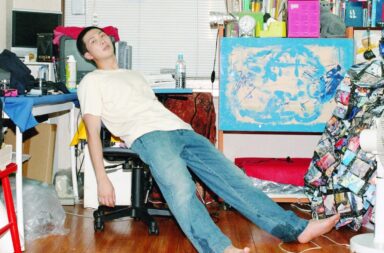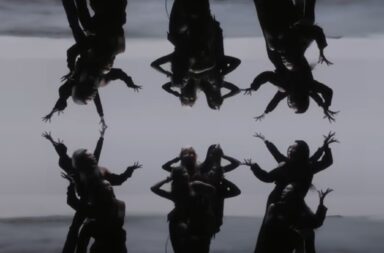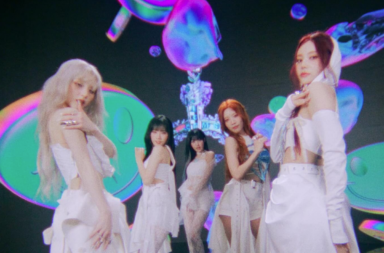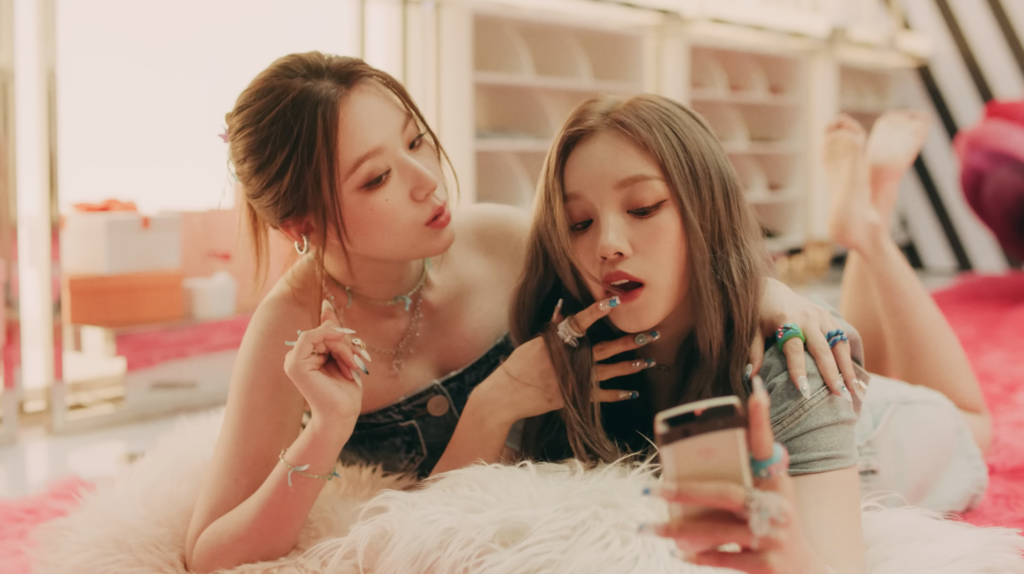
MVs are often the centrepiece of an artist’s comeback, adding depth to their concept and building their image. Reviewing offerings from rookies to veterans, Gina and Sara discuss their favorite MV picks so far this year.
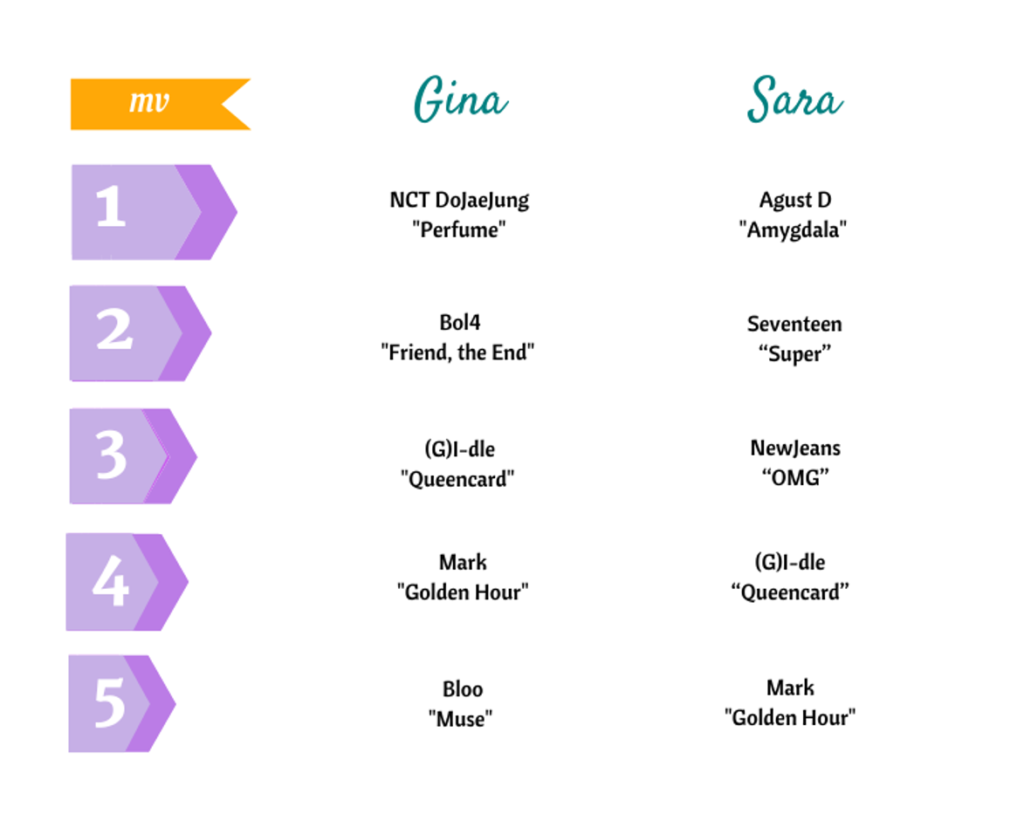
Gina: 2023 is bursting with new and old talent. We saw the rise of many new names such as NewJeans and Le Sserafim, and got to enjoy household names making new strides in their music – such as (G)I-dle, who’ve been releasing hit after hit ever since their legendary “Tomboy” comeback. Since we both chose “Queencard,” why don’t we start off the discussion with this MV?
Sara: 2023 has been quite the year! In the past, writers have sometimes struggled to establish their top MVs because of the slim pickings (honestly, I felt that). This year, however, I already had most of my list put together. If anything, it was tough to narrow down my shortlist to the top 5. In the end, I focused on MVs with out-of-the-box creativity, message enhancement, and that furthered artistic identity.
(G)I-dle has been particularly formidable since they came back with “Tomboy,” following this earworm rock track with the sharp social commentary of “Nxde.” But “Queencard” might top them both in my eyes. The women of (G)I-dle have taken their careers as musicians in the public spotlight very seriously, and the “Queencard” MV only enhances the powerful message of acceptance that the members champion.
(G)I-dle take on the Y2k aesthetic a la burn book style and encourage unflinching self-confidence, especially in the face of dreaded mirrors. They hint at a Mean Girls-sequel plot line, as a continuation of the popular vs. nerdy girl stereotype in their B-side pre-release “Allergy.” Yet, “Queencard” refuses to entertain a girl hate story, instead leaning into friendship and finding love for yourself because you are yourself. (G)I-dle are a much-needed voice of empowerment, and I’m looking forward to what they release next. What about “Queencard” did it for you, Gina?
Gina: “Queencard” brought something new and polished, while still keeping the momentum of (G)I-dle strong. Like you mentioned, their theme of empowerment continues to run in their releases, which is refreshing amongst a sea of competition. I think what made it safe from veering into predictable rivalry was having the girls dance in pairs, as well as Miyeon hugging Minnie when it seemed like she’d approach her man – referencing our biases when it comes to female friendships.
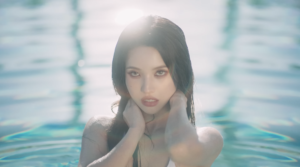
Not to mention, the quality of the sets was top-notch – utilizing a club and hospital (fully staffed, might I add), boutiques and a pool, and having newspapers fly. There were a lot of new, fresh scenes and substance, but it came around perfectly at the end with Soyeon choosing to leave the place and embrace herself as she is. Honestly, though, I’d love to see another dance-off with the hospital staff – that was the cherry on top, and we definitely need more of that.
Another girl group you listed is NewJeans – what made “OMG” top your list?
Sara: I love how NewJeans’ MVs always bring something new to the table. “Attention” was bursting with a fresh Y2K vibe, which was buoyed by the track, subtle, but attention-grabbing (haha). “Ditto,” too, dove into a complex narrative, focusing on the parasocial relationship between idols and fans. Despite having an aura of mystery, “Ditto” still managed to tap into the early aughts feel, complete with camcorders, romanticized school uniforms/high school years, and intentionally shaky camera work.
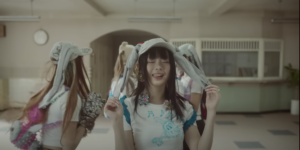
“OMG” combines the best of both “Attention” and “Ditto.” It furthers the thoughtfulness (and sometimes scary nature) of “Ditto” while probing into NewJeans’ artistic identity, which “Attention”, as the group’s debut song, formed the foundation of. The members dive deep into their idol identity in “OMG,” their fictional counterparts taking this job so literally that they are no longer human beings. Reality and the mental institution where they are blurs, along with their senses of self (Hanni’s voice even becomes the monotonic tone of Siri). “OMG” raises the question: can idols ever just be themselves without needing to be an “entertainer” 24/7?
Bol4 is the last female artist that made it onto our lists! “Friend, the End” nearly made my final five. How did it capture your attention?
Gina: Oh wow, we definitely have similar tastes! “Friend, the End” may not be that different from the usual friends-to-lovers trope, but it was intensely cinematic and nostalgic. The idea to juxtapose past and present, to have the adult duo walk through their memories, directly was creative and cute. Usually, the common course of action would be flashbacks – but instead, we get more of a “what would’ve been” vision by bringing the past and present into one cohesive shot. The plot is further brought to completion by the couple revisiting their doodles by the stairwell, which was what had started everything.
Indeed, it was made all the more realistic for both characters and viewers – it gave us the position of watching their timeline unfold inside their heads, with all the details present. A real, live love story if there was one.
On the other side of a happy love story is a turn to self-reflection, if not darkness. How did Agust D’s “Amygdala” make it to your list?
Note: The following MV references self-harm & suicide ideation. Readers are advised to proceed with care.
If you or anyone you know is experiencing distress, a list of helpline numbers from around the world can be found here https://findahelpline.com/i/iasp
Sara: Agust D’s work always stands out to me because of his rawness. His music is for him—and by extension, for others who need it, but it’s always first created for him—and filtering out the too “intense” parts is rarely an option.
Lyrically, “Amygdala” is already overflowing with vulnerability, as Agust D pours his emotions out, focusing on his parents’ health and his own shoulder injury. The track’s MV, however, visualizes these raw edges. The (very few) sets may be shiny and stark, but they are places of powerful emotions and, as you said, darkness.
The artist spends most of his time in a tiny space, composed of a comfortable-looking gray couch and a white door that is attached to nothing and may lead to nothing. The reality of isolation is overwhelming, and viewers witness him trying to fight it sometimes, having no energy at others. He seems to have no choice but to listen to this darkness. Agust D funnels his trauma and depression through “Amygdala,” and by doing so, he has created a lifeline for those who also struggle alongside him.
Your first choice is a bit different from mine! How did the sweet scent of NCT DoJaeJung make it to the top for you?
Gina: “Perfume” truly enamored me with its many charms. I don’t think there are many MVs I consider perfect, but this was one of them. Everything from direction to styling, choreography to setting, aesthetics, and solo shots – all of these meshed together to form a beautiful perfume ad for these handsome men. I genuinely enjoyed the creativity, details, and budget which allowed each member to shine through their own color and scent. No one part was a waste either, with every second contributing to the overarching theme of using perfume as a personal vessel to communicate feelings of love.
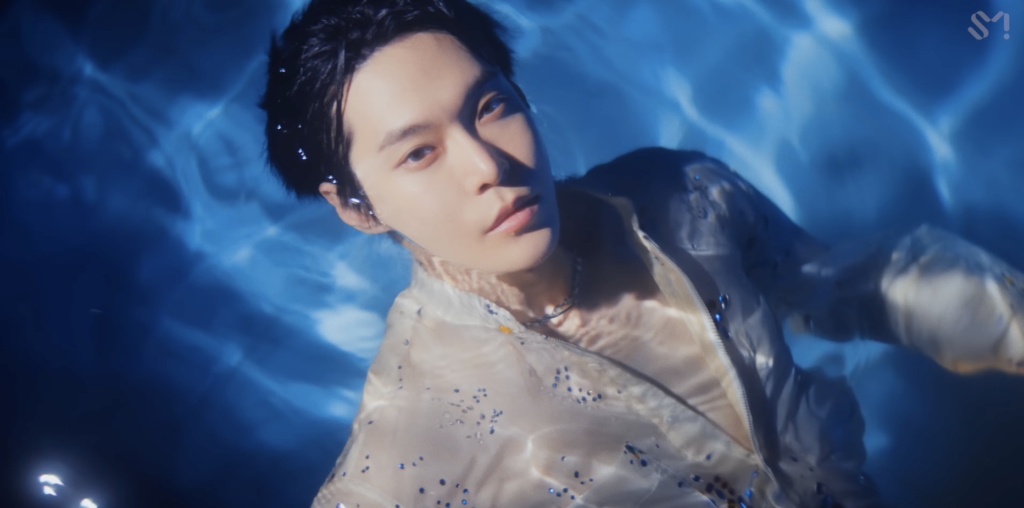
I also liked that it showed their maturity as individual artists, apart from the group or other subunits they’ve participated in. Part of the reason why I was so blown away was because this beautiful, sultry production was solely made for these three. It was as if a veil was lifted, and we got to view them grow more into themselves as performers. This kind of concept must be an ongoing thing for this unit, it must.
Speaking of NCT, I see we both added Mark to our list. What charmed you the most with “Golden Hour”?
Sara: As you witnessed, I was torn between including Mark’s cheeky “Golden Hour” or Taeyong’s solo debut “Shalala.” Obviously, “Golden Hour” won this one (but “Shalala” is definitely one of my honorable mentions), mainly because of how Mark it is. I can’t imagine anyone else in the K-pop industry—or even the music industry at large—creating something like this MV and song with the same impact as NCT’s very own golden boy.
“Golden Hour” is kind of odd, and this amalgamation of textures, sounds, and slight offbeat-ness is what makes the MV so spellbinding. It reminds me of the poems Mark posted on his Instagram when he first created his account, which was set against lucid shapes and forms. The rapid collage feel gives the MV a vulnerable, grounded, and humorous vibe, unlike the usually extremely polished videos of the K-pop industry.
This rock track on its own is already a bop, but the MV elevates it to a piece of unique art with that distinct “Mark” touch. He takes the egg imagery—courtesy of Gordon Ramsey essentially saying the NCT idol can’t make eggs—and expands it into a song pulsing with confidence and a quirky smile. During the bridge, Mark rambles off one of his serious-sounding phrases, but pokes fun at himself by later chuckling and saying, “Wait, but what does that mean?” The icing on top is when he turns around to take a photo of the vibrant sunset behind him, which ends up being just a screen on a truck. “Golden Hour” is delightfully tongue-in-cheek and extremely Mark.
What about “Golden Hour” placed it on your list?
Gina: Sara, I’m right there with you–Mark is our golden egg boy, and he’s the sole master of the carton (other than Gordon Ramsey I guess).
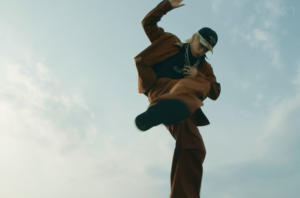
Overall, I share the same sentiments, in that it is inherently not serious, very tongue-in-cheek, and a fun mish-mash we didn’t know we needed. Inspiration truly can come from anywhere, and mixing odd poetry with mass media–an egg jab, no less–is a true art form.
I appreciate the high quality of the entire production as well; Mark wastes no time and scenery to make his points on individuality, media, and quirky pick-up lines. From the color scheme to the random CG egg scenes, to the shout-out to Gordon Ramsey and the black screens describing the yolk as a golden sun to admire. Writing, directing, imagery, color palette, topped off with indispensable lyrics and the ultimate “Mark” touch? It is quite incomparable–the breakfast’s diamond, every golden hour.
It’s also powerfully addicting, something we can listen to every morning while mixing our scrambled egg batter.
On the note of male solo artists, I’ll segway into Bloo’s “Muse” as well.
Note: The following MV references sexual assault. Readers are advised to proceed with care.
At first glance, “Muse” seems like a typical hip-hop MV with cool shots and perhaps a rated scene. But, upon closer look–particularly with the stills, which focus on body language (fingers; tension; facial expressions) and scratches on the actress’s face–brings more chills as we go in deeper. They’ve used clever subtlety to bring tension and dread to what unfolds, zooming in on body language to silently express a dark sequence of events.
Later on, the tension and struggle become more apparent, as it seems this pairing is not entirely consensual. Yet, the plot decides to do another backflip, as the final victor emerges quite unexpectedly–though was it worth it? Is the danger of being considered a “muse,” an alluring target, a body that’s desirable, too steep? Or is it merely a reflection of how dark intimacy can get in the hands of urgent power?
And lastly, who is to blame for the outcome? “Muse” might seem merely dramatical onscreen, but it is painfully stark for many, and presents an all-too-common fear we may all hold deep inside. The price of being a muse for even one person may be nothing, or may be greater than our life.
But, to end on a brighter note – how did Seventeen impress you with “Super”?
Sara: What an MV to end our conversation on! Seventeen’s “Super” comeback (pun intended) and the MV direction they chose this time around may have puzzled some. The group is well-known for its aesthetic settings, solo shots that are liberally sprinkled throughout, and synchronized dancing. Unlike Mark’s “Golden Hour,” which seems befuddling and complex but is actually deceivingly simple, Seventeen’s “Super” seems extremely on-the-nose, but it’s actually filled with subtle details that elevate the superstars’ own story through referencing famous ones.
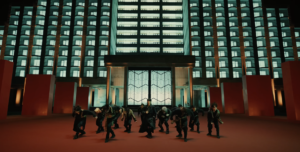
“Super” maintains one grandiose set, complete with soaring pillars. The red floor and the glowing red behind the members envelop them in a feeling of power and the fantastical. These elements, while simple, lend themselves to the rest of Seventeen’s narrative, which is driven by clever references to Journey to the West, Sun Wukong, and Son Goku from Dragon Ball.
But, of course, at the root of “Super” is the choreography. Seventeen are performers, there is no denying that. From Woozi sitting on a throne of people to the 13 members’ perfectly-timed and finely-tuned shock motion choreography, “Super” could not work without every member doing their part—even doing it above and beyond. As Seventeen emphasize in the chorus, “I love my team, I love my crew.” And that they sure do.
Overall, 2023 has been off to a very strong, artistic start. The bar has been set higher, with every artist mentioned (and not mentioned) redefining their palette and capabilities for fans to rejoice in.
(YouTube [1] [2] [3] [4] [5] [6] [7] [8]; Images via SM Entertainment, CUBE Entertainment, HYBE Labels, Shofar Music, & UNCUTPOINT)
